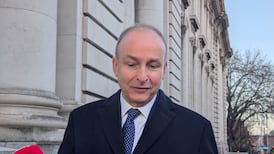LITERARY CRITICISM: JOHN WILSON FOSTERreviews The Fire i' the Flint: Essays on the Creative Imaginationsedited by Mary Shine Thompson, Four Courts Press, 200pp €50
THE DISTINGUISHED contributors to the third series of Seamus Heaney Lectures at St Patrick’s College, Drumcondra, were asked what role imagination plays in creative processes, artistic and otherwise, and what role creativity plays in our daily engagement with the world. Here are the answers and they range from the revelatory to the unhelpful.
The first question has been asked throughout the history of aesthetics but only a few of the lecturers display (or choose to display) acquaintance with that history, with the result that there is some reinvention of the wheel. Meanwhile, the invited artists understandably content themselves with their own artistic medium.
The second question was asked in order to allow the educators attached to St Patrick’s College to draw on their own expertise, though one of the visitors, Seymour Papert, the South African-born MIT emeritus professor, also addresses the classroom, advancing the claim that digital technology can release creativity in children and is education’s chief hope, a claim that could have done with more actual examples of creativity in children through the medium of technology.
The editor, Mary Shine Thompson, Dean of Research and Humanities at St Patrick’s, makes a good fist of claiming a common pursuit among the contributors, under the aegis of British Romanticism, but perhaps it is to the book’s good that it is no more than the sum of its parts. Seamus Heaney, the lecture series’s tutelary spirit, charts the poet Patrick Kavanagh’s “individuation” but does so by drawing on James Joyce and TS Eliot, two unlikely Romantics. The Nobel laureate privileges the artist’s creativity over his “responsibility”, by which he seems to mean responsiveness to society, though both are necessary in his ideal art.
Nor is the eye-catching “visual essay” by the English Op artist Bridget Riley readily assimilated to Romanticism. Hers is a suite of 41 reproductions of her abstract Op art interspersed with reproductions of paintings (or details thereof) by Georges Seurat, whose pointillism has inspired her. The essay is wordless so the reader is entirely free to make inferences about the practice and theory of creative imagination. Riley did say in a 1996 lecture that a work of art is the translation of a text inside the artist (and that most people dont have such a text inside them), so the absence here of commentary is quite logical if disorientating for the “reader”.
Riley and Heaney are almost alone among the contributors in not paying service to the idea that creativity is universal among us. The German composer Peter Michael Hamel believes musical experiment and improvisation stimulate creativity in amateurs and professionals alike; indeed, “everyone is creative”, especially children. And every culture too, Hamel being a prophet of world music. Nonetheless, Hamel’s essay is an enormously technical performance, a stiff workout for the reader. The Irish writer Alan Titley wishes to demonstrate (rather than analysing) the ubiquity of creativity as linguistic energy, but this is a chancy enterprise that can sink to a wobbly parody of WR Rodgers: “Literary criticism is always blubber and blabberings, it is flam and babble, the murmuring chant of sighs on brimming ears”.
By contrast, the educators Ciarán Benson, Kieran Egan and Patricia Flynn, are soberly helpful despite talk of cognitive tools, tricks and skills. Jones Irwin rightly and bravely (under the circumstances of the lecture series) challenges Heaney's marking down of Philip Larkin's poem Aubade. Irwin has fresh insights into this extraordinary poem, but I wonder how many will be convinced by his claim that it is a familiarly postmodernist work. Certainly Aubadeburies Romanticism as well as Religion, but I fear it also buries Poetry and by implication Art (postmodernist or not) – if we let it.
The proper context for Aubadecan be found in Susan MP McKenna-Lawlor's stunning precis of western scientific concepts of the universe, Voyages at the Edge of Forever. The essay, despite the editorial claim, does not really bridge the concepts of creativity in the arts and sciences, but that is of no consequence save for the book's subtitle. This is a brilliant telescoping of major cosmological explanations of the origin, evolution, and prospect of the universe. This humbling essay is worth the price of admission.
John Wilson Foster is a Visiting Senior Research Fellow at Queen's University Belfast. His book Irish Novels 1890-1940appeared in 2008 and Between Shadows: Modern Irish Writing and Culturewill appear this year






